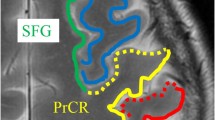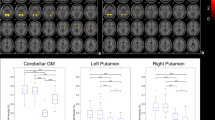Abstract
Although the sensitive detection of putaminal iron deposition by T2*-weighted imaging (T2*-WI) is of diagnostic value for multiple system atrophy (MSA), the diagnostic significance of the pontine hot-cross bun (HCB) sign with increased ferritin-bound iron in the background remains unknown. We retrospectively evaluated the cases of 33 patients with cerebellar-form MSA (MSA-C) and 21 with MSA of the parkinsonian form (MSA-P) who underwent an MRI study with a 1.5-T system. Visualization of the HCB sign, posterior putaminal hypointensity and putaminal hyperintense rim on T2*-WI was assessed by two neurologists independently using an established visual grade, and were compared with those on T2-weighted imaging (T2-WI). The visual grade of pontine and putaminal signal changes was separately assessed for probable MSA (advanced stage) and possible MSA (early stage). T2*-WI demonstrated significantly higher grades of HCB sign than T2-WI (probable MSA-C, n = 27, p < 0.001; possible MSA-C, n = 6, p < 0.05; probable MSA-P, n = 13, p < 0.01). The visual grade of the HCB sign on T2*-WI in the possible MSA-C patients was comparable to that in the probable MSA-C patients. Although the HCB sign in MSA-P was of lower visual grade than in MSA-C even on T2*-WI, some patients showed evolution of the HCB sign preceding the appearance of the putaminal changes. These findings suggest that T2*-WI is of extreme value for detecting the HCB sign, which is often cited as a hallmark of MSA. The appearance of the HCB sign on T2*-WI might not only support but also improve the diagnosis of MSA.

Similar content being viewed by others
References
Gilman S, Wenning GK, Low PA, Brooks DJ, Mathias CJ, Trojanowski JQ et al (2008) Second consensus statement on the diagnosis of multiple system atrophy. Neurology 71:670–676
Chandran V, Stoessl AJ (2014) Imaging in multiple system atrophy. Neurol Clin Neurosci 2:178–187
Brooks DJ, Seppi K (2009) Proposed neuroimaging criteria for the diagnosis of multiple system atrophy. Mov Disord 24:949–964
Kraft E, Trenkwalder C, Auer DP (2002) T2*-weighted MRI differentiates multiple system atrophy from Parkinson’s disease. Neurology 59:1265–1267
von Lewinski F, Werner C, Jorn T, Mohr A, Sixel-Doring F, Trenkwalder C (2007) T2*-weighted MRI in diagnosis of multiple system atrophy. A practical approach for clinicians. J Neurol 254:1184–1188
Arabia G, Morelli M, Paglionico S, Novellino F, Salsone M, Giofre L et al (2010) An magnetic resonance imaging T2*-weighted sequence at short echo time to detect putaminal hypointensity in Parkinsonisms. Mov Disord 25:2728–2734
Ozawa T, Paviour D, Quinn NP, Josephs KA, Sangha H, Kilford L et al (2004) The spectrum of pathological involvement of the striatonigral and olivopontocerebellar systems in multiple system atrophy: clinicopathological correlations. Brain 127:2657–2671
Visanji NP, Collingwood JF, Finnegan ME, Tandon A, House E, Hazrati LN (2013) Iron deficiency in parkinsonism: region-specific iron dysregulation in Parkinson’s disease and multiple system atrophy. J Parkinsons Dis 3:523–537
Horimoto Y, Aiba I, Yasuda T, Ohkawa Y, Katayama T, Yokokawa Y et al (2002) Longitudinal MRI study of multiple system atrophy - when do the findings appear, and what is the course? J Neurol 249:847–854
Yabe I, Soma H, Takei A, Fujiki N, Yanagihara T, Sasaki H (2006) MSA-C is the predominant clinical phenotype of MSA in Japan: analysis of 142 patients with probable MSA. J Neurol Sci 249:115–121
Geser F, Seppi K, Stampfer-Kountchev M, Kollensperger M, Diem A, Ndayisaba JP et al (2005) The European Multiple System Atrophy-Study Group (EMSA-SG). J Neural Transm 112:1677–1686
Gilman S, May SJ, Shults CW, Tanner CM, Kukull W, Lee VM et al (2005) The North American Multiple System Atrophy Study Group. J Neural Transm 112:1687–1694
Lin DJ, Hermann KL, Schmahmann JD (2014) Multiple system atrophy of the cerebellar type: clinical state of the art. Mov Disord 29:294–304
Wenning GK, Tison F, Seppi K, Sampaio C, Diem A, Yekhlef F et al (2004) Development and validation of the Unified Multiple System Atrophy Rating Scale (UMSARS). Mov Disord 19:1391–1402
Ito S, Shirai W, Hattori T (2007) Evaluating posterolateral linearization of the putaminal margin with magnetic resonance imaging to diagnose the Parkinson variant of multiple system atrophy. Mov Disord 22:578–581
Tha KK, Terae S, Tsukahara A, Soma H, Morita R, Yabe I et al (2012) Hyperintense putaminal rim at 1.5 T: prevalence in normal subjects and distinguishing features from multiple system atrophy. BMC Neurol 12:39. doi:10.1186/1471-2377-12-39
Deguchi K, Sasaki I, Touge T, Tsukaguchi M, Takeuchi H, Kuriyama S (2004) Abnormal baroreceptor-mediated vasopressin release as possible marker in early diagnosis of multiple system atrophy. J Neurol Neurosurg Psychiatry 75:110–115
Takao M, Kadowaki T, Tomita Y, Yoshida Y, Mihara B (2007) ‘Hot-cross bun sign’ of multiple system atrophy. Intern Med 46:1883
Fujii S, Matsusue E, Kinoshita T, Sugihara S, Ohama E, Ogawa T (2007) Hyperintense putaminal rim at 3T reflects fewer ferritin deposits in the lateral marginal area of the putamen. AJNR 28:777–781
Ishigame K, Yagishita A (2010) Diagnostic imaging of multiple system atrophy. Neurol Med (Tokyo, Japan) 73:340–345 (in Japanese)
Watanabe H, Ito M, Fukatsu H, Senda J, Atsuta N, Kaga T et al (2010) Putaminal magnetic resonance imaging features at various magnetic field strengths in multiple system atrophy. Mov Disord 25:1916–1923
Kanazawa M, Shimohata T, Toyoshima Y, Tada M, Kakita A, Morita T et al (2009) Cerebellar involvement in progressive supranuclear palsy: a clinicopathological study. Mov Disord 24:1312–1318
Lee YC, Liu CS, Wu HM, Wang PS, Chang MH, Soong BW (2009) The ‘hot cross bun’ sign in the patients with spinocerebellar ataxia. Eur J Neurol 16:513–516
Muqit MM, Mort D, Miskiel KA, Shakir RA (2001) “Hot cross bun” sign in a patient with parkinsonism secondary to presumed vasculitis. J Neurol Neurosurg Psychiatry 71:565–566
Soares-Fernandes JP, Ribeiro M, Machado A (2009) “Hot cross bun” sign in variant Creutzfeldt-Jakob disease. AJNR 30:E37
Oji Y, Hatano T, S-i Kubo, Mori A, Nakazato T, Hattori N (2013) Cerebellar ataxia and the “hot cross bun” sign in association with human immunodeficiency virus infection. Neurol Clin Neurosci 1:127
Acknowledgments
This work was partly supported by JSPS KAKENHI Grant No. 24591297.
Conflicts of interest
On behalf of all authors, the corresponding author states that there is no conflict of interest.
Ethical standard
The study was approved by the appropriate ethics committee and has therefore been performed in accordance with the ethical standards laid down in the 1964 Declaration of Helsinki.
Author information
Authors and Affiliations
Corresponding author
Rights and permissions
About this article
Cite this article
Deguchi, K., Ikeda, K., Kume, K. et al. Significance of the hot-cross bun sign on T2*-weighted MRI for the diagnosis of multiple system atrophy. J Neurol 262, 1433–1439 (2015). https://doi.org/10.1007/s00415-015-7728-1
Received:
Revised:
Accepted:
Published:
Issue Date:
DOI: https://doi.org/10.1007/s00415-015-7728-1




